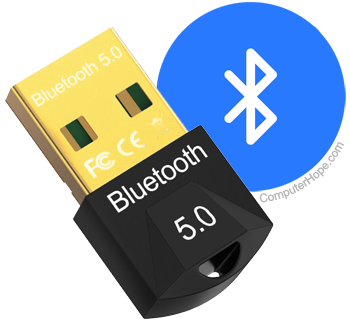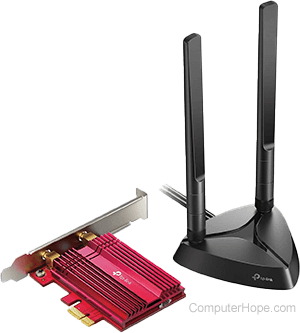Bluetooth

Bluetooth is a computing and telecommunications industry specification that describes how devices can communicate with each other. Bluetooth devices include computers, keyboards and mice, personal digital assistants, and smartphones.
Bluetooth is an RF (radio frequency) technology operating at 2.4 GHz and has an effective range of 32 feet (10 meters), varying by power class, a transfer rate of 1 Mbps, and a throughput of 721 Kbps.
How is Bluetooth used?

An example of how Bluetooth could be used is connecting a smartphone to a computer without wires or special connectors. The picture shows a USB (universal serial bus) Bluetooth adapter. This adapter could be plugged into the USB port to get Bluetooth access on a computer.
Below are examples of how Bluetooth is used.
- Bluetooth headphones - Headphones that connect to any Bluetooth device.
- Bluetooth keyboard and Bluetooth mouse - Wireless keyboards and mice.
- Bluetooth speaker - Speakers that connect to any Bluetooth audio device.
- Bluetooth car - A car with Bluetooth can make hands-free calls in the car.
- Bluetooth watch or Bluetooth health monitor - Bluetooth wrist devices that transmit data to other devices over Bluetooth.
- Bluetooth lock - Door lock that lets you remotely lock and unlock a door.
What is a Bluetooth card?

A Bluetooth card is an expansion card installed into a desktop computer to give it Bluetooth capabilities or a stronger Bluetooth signal. The picture shows a PCIe (PCI Express) Wi-Fi card from TP-Link that allows the computer to communicate over Wi-Fi 6 and Bluetooth 5.2. In this example, the card also has antennas not connected directly to the card, which allows the antennas to be better positioned.
This Bluetooth card and similar cards can be purchased through an online retailer like Amazon.
What is the Bluetooth symbol?

The Bluetooth symbol resembles two and a half triangles pointing to the right. The symbol is a bind-rune representing "H" and "B," the initials for Harald Bluetooth, a Denmark Viking king (c. 958 - c. 970) who helped unite Denmark and Norway. It is named after Harald Bluetooth because Bluetooth was designed as a universal wireless technology that would similarly unite devices.
Who invented Bluetooth, and when?
The answer to this question varies based on whether you consider the technology or device application as the invention date. However, the most widely-credited inventor is Jaap Haartsen, who laid the foundations for the technology that became known as Bluetooth in 1994.
What is Bluetooth Low Energy?
As the name implies, Bluetooth Low Energy (sometimes BLE or Bluetooth LE) is a variation of classic Bluetooth that uses less energy. It is utilized with wearable devices like fitness trackers like smartwatches and other instances where power consumption takes precedence over transfer rate. Not surprisingly, mobile operating systems like iOS, Android, and BlackBerry OS are all compatible with BLE. However, Windows (version 8 and newer), macOS, and Linux natively support Bluetooth Low Energy as well.
BLE technology functions in the 2.4 GHz band as Bluetooth, but stays dormant until a connection is triggered by a data transmission request. The active connection occurs briefly, lasting the few milliseconds required to transfer a small data portion, unlike the constant connection maintained by Bluetooth. While this intermittent data transfer isn't great for streaming music or phone calls, it serves as an energy-efficient option for applications engaging in occasional data exchanges.
Wibree
Developed by Nokia in 2006, Wibree was a short-range wireless communication technology designed to operate in the 2.4 GHz frequency band (sound familiar?). However, due to challenges and competition from other emerging technologies, Wibree merged with the Bluetooth Special Interest Group.
Eventually, this series of events led Wibree to be integrated into Bluetooth 4.0 as Bluetooth Low Energy in December 2009. BLE retained the low-power characteristics of Wibree and (as we mentioned above) became a widely-adopted standard for short-range wireless communication in IoT (Internet of Things) devices and other applications.
Access point, Bluetooth and devices, Cell phone, Cordless, Infrared, Native, NFC, Phone terms, Transceiver
